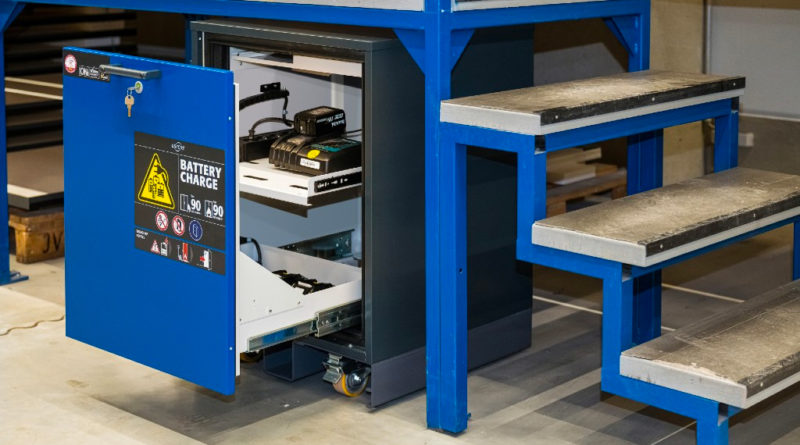Opinion: Taking charge of eBike battery safety
Les Day, UK Regional Sales Manager for asecos Ltd, talks through some of the considerations and best practices when storing eBike batteries…
RISKS
The major problem with lithium ion batteries is the so-called Thermal Runaway. This is a process that starts in one cell of a battery, leading to a temperature increase that causes the cell to disintegrate and suddenly release its stored energy.
This release of energy creates a domino effect, causing adjacent cells to also disintegrate, releasing more energy and temperature increases. This chain reaction can be very unpredictable – a slow smouldering fire with occasional flare-ups or a rapid fire / explosion.
Are there warning signs that a battery is a risk? Not always, but the main ones to look out for are:
- Heat: Batteries will generate some heat when charging or in use but if a battery feels excessively hot to the touch, there’s a good chance it is developing a problem.
- Swelling: If a battery looks swollen or misshapen, stop using it.
- Noise: I have seen many videos where the batteries have started to hiss before a fire starts.
- Smoke: Pretty obvious but if a battery or device is smoking, a fire has already started.
Apart from that, a battery that takes longer than normal to charge or fails to fully charge can also be taking as warning signs.
REGULATIONS ALREADY IN PLACE
At the moment, there are no specific regulations for the storage and charging of batteries.
For the time being, we have to rely on organisations such as the Fire Protection Association, the RISCAuthority and the Fire Industry Association who have issued general guidance documents.
The London Fire Brigade have also put together a good guide. See: www.london-fire.gov.uk/safety/lithium-batteries/
A Private Members Bill was tabled in the Commons last September but this was more to do with industrial battery storage. It was due to have a second reading last month but this is now delayed until next November.
COMPLIANCE
Without legislation there is very little to say on compliance. All you can suggest is “good practice” such as:
Handling and Use:
- Handle batteries/battery-powered devices cautiously to not damage the battery casing or connections.
- Keep batteries from contacting conductive materials, water, seawater, strong oxidizers and strong acids.
- Don’t place batteries in direct sunlight, on hot surfaces or in hot locations.
- Inspect batteries for signs of damage before use. Never use and promptly dispose of damaged or puffy batteries.
- Keep all flammable materials away from operating area.
- Allow time for cooling before charging a battery that is still warm from usage and using a battery that is still warm from charging.
CHARGERS & CHARGING PRACTICE
- Never charge a primary (disposable lithium or alkaline) battery; store one-time use batteries separately.
- Charge or discharge the battery to approximately 50% of capacity before long-term storage.
- Disconnect batteries immediately if, during operation or charging, they emit an unusual smell, develop heat, change shape/geometry, or behave abnormally. Dispose of the batteries.
- Remove cells and packs from chargers promptly after charging is complete. Do not use the charger as a storage location.
- Charge and store batteries in a fire-retardant container when practical.
- Do not parallel charge batteries of varying age and charge status
- Do not overcharge (greater than 4.2V for most batteries) or over-discharge (below 3V) batteries.
STORAGE
- Keep batteries away from combustibles.
- Remove batteries from the device for long-term storage.
- Store the batteries at temperatures between 5°C and 20°C (41°F and 68°F).
- If practical, store batteries in fire-resistant storage cabinets with monitoring capabilities.
- Visually inspect battery storage areas at least weekly.
- Charge batteries in storage to approximately 50% of capacity at least once every six months.
DISPOSAL
- Dispose of damaged cells and cells that no longer hold a substantial charge.
- Dispose of used batteries by taking them to a dedicated collection/recycling facility.
- Never throw batteries into general waste bins!
IMPACT ON LIABILITY (INSURANCE)
Many insurance companies, such as AXA, Zurich, Allianz etc. are alert to the dangers of lithium ion batteries and are starting to advise clients that they need to look at sae storage / charging. AXA, in particular, have warned of the dangers posed by lithium batteries in e-bikes and scooters.
SOLUTIONS
Many companies have approached us, not necessarily from the eBike sector, informing us that their insurance advisors, fire inspectors etc. have instructed them to purchase cabinets that provide 90-minutes fire resistance, for storing and charging their Li-On batteries.
Whilst there are numerous 90-minute cabinets available, these usually meet the EN14470-1 standard and are thus certified to provide fire resistance from the outside in. However, as the risk is with the batteries themselves, they actually require a cabinet that provides fire resistance from the inside out i.e. cabinets that have dual certification, for example EN14470-1 and EN1363-1.
asecos product is available to the UK cycling trade via Madison.



